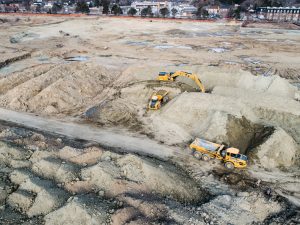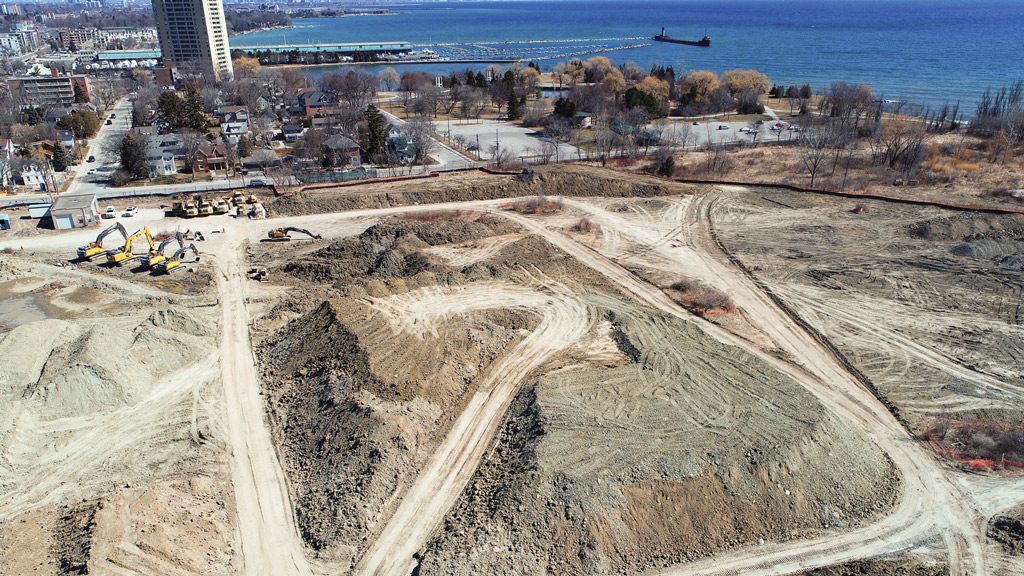With large rock trucks moving and stockpiling tons of earth and drones flying overhead, a mammoth remediation of the former Texaco/Imperial Oil refinery on the shores of Lake Ontario could conjure up images from an old war movie.
But that activity is the forerunner of one Canada’s largest infill projects on a brownfield site in the Port Credit area of Mississauga, Ont. The project marks a new chapter in the history of the site which originally began as a brick factory in the late 1800s.
“There may be projects of a similar scale in the planning stage. But with this one the rubber has hit the road,” says Kilmer Brownfield Equity Fund president David Harper.
Stretching from Lakeshore Road West to the Lake Ontario waterfront and from Pine Avenue to Mississauga Road, the site will eventually be transformed into Port Credit West Village, a mixed use community of approximately 2,500 residential units, 13,820 square metres of retail space, 22,750 square metres of commercial, and a 4.8-acre park along the waterfront.
The remediation and the ensuing redevelopment are being spearheaded by West Village Partners, a development consortium consisting of the Kilmer Group, Dream Unlimited, Diamond Corp., and Fram + Slokker.
Bordered on the east by the Old Port Credit Village Heritage Conservation District and the more recent Cranberry Cove community on the west, Port Credit West Village will be an urban-style community based on environmental, planning and market use principles, says Harper.
Bringing the project to fruition, however, has and will continue to be a complex venture in terms of the planning, regulatory approvals, and the construction. It has also required input and support from residents of the two communities and the Port Credit BIA (Business Improvement Area), he says.
The refinery was closed and dismantled three years ago. Imperial Oil, which had acquired the property but never actually operated the refinery, “tried to reposition the property but didn’t know how to go about that.”
Then, a couple of years ago, the oil giant issued both Requests for Proposals and Requests for Qualifications from parties interested in purchasing and redeveloping the vacant and fenced off property.
Toronto-based Kilmer specializes in the remediation/redevelopment of brownfield sites and had been interested in the refinery site for some time. It organized a team of partners which successfully submitted an application and purchased the property. That process, though, was very complicated and took about 18 months to complete, he says.
It (the research) enables them to identify which areas contain impacted soils and which areas contain suitable soil for reuse within the site,
—Monisha Nandi
Kilmer Brownfield Equity Fund
“We had to show (Imperial) how we were going to remediate the property and what we going to do with the property.”
A number of municipal approvals including rezoning the land from industrial have to be obtained. Expected to take about two years, the approval process should coincide with the completion of the remediation which would then allow the redevelopment to proceed, says Harper.
Underway since January the remediation is being conducted by The Cannington Group. The consultant is Stantec. It’s a tightly organized undertaking consisting of visual inspections, soil testing, plus the use of the drones and technology, says Kilmer’s environmental director, Monisha Nandi.
Prior to the sale of the site Imperial Oil conducted extensive soil testing and that data, plus new data that Stantec has collected, is all integrated into a GPS-enabled database accessible by the its field representatives through iPads.
“It (the research) enables them to identify which areas contain impacted soils and which areas contain suitable soil for reuse within the site.”
Specific areas have been identified as having higher concentrations of soil or groundwater impacts and those are the areas targeted for excavation in the current phase, she explains.

Soils deemed impacted are moved to a designated staging area immediately adjacent a truck route. From there the material is transported to two Walker Industries landfill sites in Niagara Region which have Environmental Compliance Approval from the Ministry of the Environment to accept it as daily cover.
To keep track of the mountain of earth moved a contractor flies drones over the site at least once a week or as required to survey specific work areas. Approximately 800,000 tons of soils are expected to be hauled there during the duration of the remediation, says Nandi.
But the protective measures won’t end there. All the units at Port Credit West Village will have underground parking: “which create a gap against and residual contaminates.”
Port Credit West Village is one component of the City of Mississauga’s Inspiration Port Credit, a vision plan which also includes the redevelopment of lands a 1 Port Street. Last year the plan won a Brownie Award for Communication, Marketing and Public Engagement. The awards recognize the rehabilitation efforts of brownfield sites in Canada.
Along with planned redevelopment for Mississauga’s Lakeview area, the two projects “will transform the city’s water’s edge into a vibrant, sustainable, mixed-use communities,” says planning and building commissioner Andrew Whittemore.





Recent Comments
comments for this post are closed